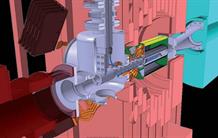An international team led by IRFU and the Japanese research institute RIKEN was able to study the structure of a neutron-rich zirconium nucleus (110Zr)—a first, calling certain models into question. Produced by an accelerator at RIKEN and measured by the MINOS detector, this heavy nucleus proves to be more deformed than expected.
The study of heavy elements makes it possible to better understand the properties of the nuclear interaction binding the nucleons within the nucleus, as well as to test theoretical models.
Yet, for nucleus 110Zr, the predictions from models strongly diverged. While the models varied between a sphere, an ellipsoid, or a tetrahedron (similar to a pyramid), the researchers determined the shape of the isotope 110Zr for the first time in experiments and found that it is shaped as a highly distorted ellipsoid.
This result was achieved thanks to the unparalleled performance of the ERC-funded MINOS detector (Magic Numbers Off Stability). Designed and built by IRFU, MINOS allows the measurement of the excitation energy spectra of unstable nuclei, produced at low intensity through the bombardment of a thick cryogenic target of liquid hydrogen (100 mm thickness). The target is coupled to a trajectograph that makes it possible to reconstruct the location of the nuclear reactions occurring in the target. MINOS has been operating at the Radioactive Isotope Beam Factory (RIBF) of the RIKEN Nishina Center in Japan since 2014.
This work was carried out in collaboration with the Riken Nishina Center and the Institute for Nuclear Physics (IPN) in Orsay (CNRS/Paris-Sud University). The theoretical calculations were performed at various sites, including the CEA Military Applications Division Center in Bruyères-le-Châtel, as well as IRFU and IPN in Lyon.
Are There Signatures of Harmonic Oscillator Shells Far from Stability? First Spectroscopy
of 110Zr, Physical Review Letters.




